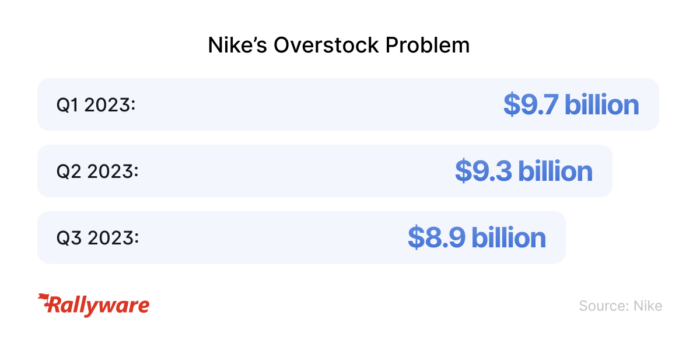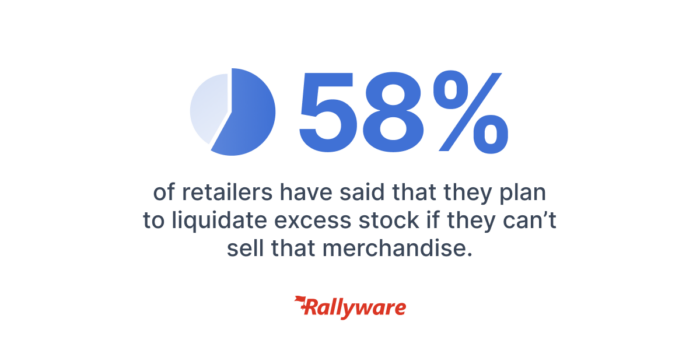Retail Workforce Enablement in 2025: The Future of Sales Training
Using Frontline Technology to Solve Overstock Problems
Following the COVID-19 pandemic, overstock remains a long-term issue for retailers at large. Short-term solutions aren’t helping. While companies like Nike have been able to clear out some of their excess inventory, the company still has around $9 billion worth of inventory. Software for retail stores can solve this pivotal issue.

One key way that Nike destocked was through promotions. Particularly during the holiday season, they offered promotions on inventory they needed to move in order to reduce their glut and thus warehousing costs. In other words, they made sure to shift their staff’s sales efforts, along with consumers’ attention, toward the right merchandise.
With the right frontline training and enablement software, it’s possible to drive sales for the right inventory items not only in the short term, but in an “evergreen” way. How is this possible? Let’s investigate the relationship between frontline tech, overstocking, and destocking mission-critical SKUs.
What Kind of Software for Retail Stores Is Out There?
Retail stores utilize a variety of software solutions to streamline operations, enhance customer experience (CX), drive workforce experience (WX), and manage various aspects of their business. Here are some common types of software for retail stores:
- Point of Sale (POS) Software: POS software is the central system used to process sales transactions. It typically includes features like barcode scanning, inventory management, sales reporting, and customer data collection.
- Frontline Enablement Software: This software for retail stores uses data collected over time to suggest the next most engaging, most productive activity for each individual frontline associate. Rallyware is an example of such software, boosting sales productivity for each individual frontline employee using tools such as learning and development and sales incentives.
- Inventory Management Software: This software helps retailers track inventory levels, reorder products, manage stockouts, and optimize inventory turnover. It can also provide insights into sales trends and help prevent overstocking or understocking.
- E-commerce Platforms: For retailers with an online presence, e-commerce platforms enable them to sell products online, manage online orders, and handle payment processing. Popular platforms include Shopify, WooCommerce, Magento, and BigCommerce. It’s important not to over-focus on e-commerce and optimize for in-store experiences as well.
- Customer Relationship Management (CRM) Software: CRM software helps retailers manage customer data, preferences, purchase history, and interactions. This information can be used to personalize marketing efforts and improve customer satisfaction. Certain frontline enablement platforms include CRM software.
- Retail Analytics Software: Retail analytics tools provide insights into sales trends, customer behavior, and other relevant data. Retailers can use this information to make informed decisions about pricing, promotions, and inventory management.
- Loyalty Program Software: Loyalty program software helps retailers create and manage customer loyalty programs, offering rewards and incentives to repeat customers.
- Mobile Payment Solutions: With the rise of mobile payments, retailers often integrate mobile payment options like Apple Pay, Google Pay, and various digital wallet apps into their POS systems.
- Supply Chain Management Software: Retailers can use supply chain management software to track the movement of goods from suppliers to stores, optimizing logistics and ensuring timely deliveries.
- Visual Merchandising Software: This software for retail stores helps retailers plan and design store layouts, displays, and signage to enhance the overall shopping experience.
- Loss Prevention Software: Loss prevention software includes surveillance, anti-theft measures, and fraud detection tools to minimize inventory shrinkage and prevent shoplifting.
- Integrated ERP Systems: Enterprise Resource Planning (ERP) systems provide an integrated solution to manage various aspects of the retail business, including finance, inventory, human resources, and more.
- Retail Analytics Tools: These tools help retailers analyze data to understand customer behavior, monitor sales trends, and make informed decisions about pricing, promotions, and inventory management.
- Feedback and Review Management Software: Retailers use these tools to gather and manage customer feedback and reviews, helping them improve their products and services.
- Digital Signage Software: This software is used to manage digital displays and signage within the store, allowing retailers to showcase promotions, advertisements, and other relevant information.
These are just some examples of the many types of software available for retail stores. The specific software a retail store requires will depend on its size, the scale of its frontline, nature of operations, and business goals. For the purposes of this article, we’ll be discussing frontline enablement software.
How Does Frontline Technology Help Solve Overstock Problems?
As we’ve mentioned, overstock is a major problem for retailers today. Warehousing excess inventory adds supply chain costs, and those costs get passed onto customers, further reducing demand. 58% of retailers have said that they plan to liquidate excess stock if they can’t sell that merchandise. So it makes sense to seek out ways to convert particular SKUs and destock.

One major problem here is psychological. Customers often feel that marked-down or promoted items are somehow deficient or out of fashion. Especially with high-ticket items, consumers want to feel that they’re making a good investment on state-of-the-art merchandise.
In this case, they might need frontline staff to help explain to him why these promoted/on-sale items are not lesser purchases, but rather good investments.
In terms of software for retail stores, workforce enablement platforms play a significant role in solving overstock problems by facilitating better collaboration, data-driven activity recommendations in real time, and efficient inventory targeting. How?
- Better Collaboration: Frontline enablement software is meant for individual staff members. The mobile platform (Rallyware, for instance) uses frontline performance data, customer preference data, external integrations, and other information sources to smart-suggest the next best productivity-enhancing activity for the individual associate. However, in Rallyware’s case, the technology helps individuals collaborate, fostering communication and messaging among teams, as well as messages from corporate or store leadership. This helps teams stay abreast of what merchandise should be moved when.
- Data-Driven Activity Recommendations: Using business rules plotted out by the retailer, frontline enablement technology crunches past and present performance data, external software (like commissions tracking platforms and inventory management software), customer preference, and other critical business data to determine what activity this individual frontline member should complete at what time. This might include what particular type of inventory to focus on when, including overstocked items.
- Efficient Inventory Targeting: Similarly, by setting up the right business rules, retailers can target specific merchandise and particular inventory levels. For instance, store operators, merchandisers, or operations specialists might decide that when an individual frontline associate reaches X level of upskilling, she will receive Y sales incentives to sell Z products. In this case, that would be a particular shoe the store needs to destock. The idea is that there’s a smart engine targeting sales activities for specific inventory items, with the aim of reaching specific inventory levels.
Software for Retail Stores to Move the Right Inventory
Overall, for those looking to get rid of expensive inventory clutter, seek out inventive ways of enabling the frontline for targeted sales. Though such technology requires expenditures, truly robust platforms will have such a return on investment that the tech pays for itself. Rallyware, for instance, has 24X ROI.
Rallyware’s performance enablement technology engages and upskills the workforce to drive higher sales. Click here to request a demo, and here to register for our upcoming webinar on overstock problems, featuring representatives from a major bike retailer and a large bike brand.
News and Insights on Workforce Training & Engagement
We’re among top-notch eLearning and business engagement platforms recognized for effective training and talent development, helping to empower distributed workforces
Subscribe
